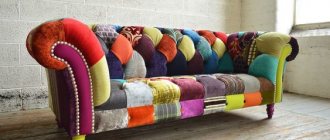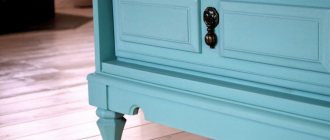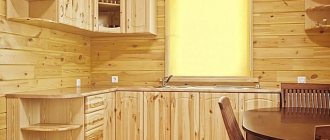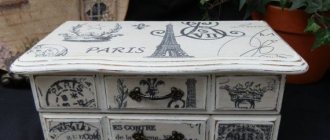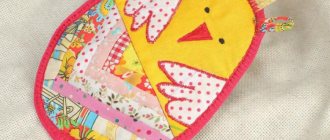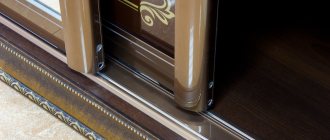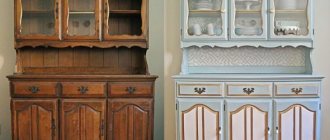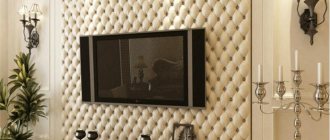People living for a long time in one unchanging environment often feel a strong desire to update their boring interior. Then the natural question arises: how to paint furniture? After all, it is she, in an updated color, that can refresh the boring interior appearance of the house. Tables, chairs, cabinets and bedside tables - this is what the arrangement of the room is formed from, but replacing them with new models every time you want to change is an extremely unprofitable idea. Thus, painting your furniture yourself becomes the best option. The following are painting tips.
Painting wooden furniture is an easy, quick way to update and refresh the look of a room.
Let's consider the attractive aspect of the question of how to refresh furniture with your own hands. First of all, this is a material benefit: you don’t have to spend a fortune on buying new fittings or the services of a professional painting craftsman. In addition, when painting yourself, you are free to show special ingenuity and creativity, giving the product the look you want.
Below are tips on how to paint furniture; We will explain in detail how to paint old furniture with your own hands, without resorting to the services of third-party specialists.
What kind of furniture can be repainted?
Thanks to modern paint and varnish coatings, any furnishings and garden furniture can be updated:
- wooden;
- metal;
- plastic;
- from pressed sawdust;
- varnished;
- laminated.
You can repaint modern and Soviet furniture. The laminate and varnish are completely removed using a grinder with a circular attachment. It is enough to sand smooth surfaces to make them rough.
Useful tips
- First, you need to study the material from which the furniture is made, the features of its pre-processing, and calculate the surface area.
- In online stores you can find all the information about paint: approximate calculation of consumption, drying speed, composition. You can also read reviews about a specific manufacturer on various websites to decide which paint is best to paint furniture with.
- Before you start painting, it is necessary to inspect the surface in good light from different angles for irregularities, since after painting, and even more so after varnishing, all roughness will be very noticeable.
- Individual parts must be painted from the ends, then move to the base.
- The paint should be applied in long strokes using the entire brush. You can even out the layer by lightly going over it with the tip of the brush.
To achieve excellent results, you do not need to save time on preparatory work. After all, a perfectly flat, primed surface not only gives a beautiful look to freshly painted furniture, but also extends its service life. It is also important to know what paint to paint old furniture so that the result meets your expectations.
What you need for work
Approximate list of materials and tools:
| Inventory | Description |
| Dye | In cans or aerosols |
| Varnish | Glossy, matte or semi-matte |
| Putty, primer | Same base as paint |
| Sandpaper | Coarse and fine grain |
| Plastic bath | For paint |
| Paint brush | With synthetic bristles, for painting small parts |
| Roller | Short pile, for large surfaces |
| Small rubber spatula | For spreading putty |
| Screwdriver | For dismantling prefabricated objects - tables, sofas, cabinets |
| Masking tape | Paste over fixed fittings |
| Newspapers, plastic film | Place under the product |
You will also need gloves and safety glasses for work if the paints and varnishes emit a pungent odor.
Required additional materials
Many families to this day keep cabinets with chairs passed down from the older generation, dating back to Soviet times, made so conscientiously that they are still able to perform their task normally. But they have one significant drawback - external “shabbyness”. In order to correct this annoying misunderstanding and finally update the appearance of the furniture, we suggest painting it yourself.
Tools and materials needed for painting furniture
In order for painting furniture with your own hands to be successful, you will first need:
- a product in need of updating;
- sufficient amount of paint;
- tape for painting;
- brushes;
- shallow container.
This is by no means a complete list. Before you start working directly, you need to treat the surface on which the paint layer will be applied.
Materials that will be useful in the process:
- putty;
- face protection (mask or goggles);
- a sufficient amount of sandpaper;
- wooden beam.
Preparatory work
To ensure an even coating, the surface must be properly prepared for painting.
Visual inspection
Before work, assess the condition of the piece of furniture. Old chairs, sofas and armchairs often need to be reupholstered. Before painting, you also need to fix wobbly legs and squeaky doors.
Removing old coating
In addition to sandpaper and the sanding attachment of the grinder, varnish is removed from furniture using solvents or heated with a hair dryer, and then cleaned off. But the easiest way to roughen a smooth surface is by sanding it with sandpaper.
Sanding
Wooden furniture is sanded along the grain lines. For better adhesion, the metal surface is degreased with acetone, alcohol or white spirit.
Puttying and priming
Deep cracks, chips and scratches that could not be smoothed out with sandpaper are covered with putty. For durable coating, latex compounds are used that form elastic compounds. As a result, the paint will not crack due to temperature changes.
Expert opinion
Zakharova Irina Yurievna
Cleaning professional with 15 years of experience. Our best expert.
Ask a Question
For metal, an anti-corrosion primer is used, and for previously painted surfaces, deep penetration compounds are used.
Before applying the primer, areas with putty are sanded again. A surface coated with a water-based primer should not be wiped with a damp cloth before painting.
See also
The best way to paint heels on boots, what you need and how to apply
Principles for choosing paint
An important selection criterion is the place where the furniture will be used. From this point of view, water-based compositions are chosen for home furnishings. They are harmless to health, resistant to abrasion, and the surface painted with them “breathes.”
They act differently if the restored sofa or armchair is planned to be placed on an open veranda. When considering different options for painting a chipboard chest of drawers white, the choice is made in favor of paints with high elasticity. Drying oil-based paints may be a suitable solution, but they take a long time to dry, and under the rays of the sun the oil layer may crack over time.
On the terrace Source pinimg.com
For furniture intended for outdoor use, other compositions with high elasticity are also suitable: alkyd-oil and alkyd. Water-based wood dyes are also intended for exterior use; they are environmentally friendly and preserve the integrity of the layer during changes in temperature and humidity.
Home furniture can be repainted using acrylic, oil or alkyd paint. A composition based on drying oil is affordable, but it is advisable to choose it for working in a vintage style. Based on the totality of its characteristics, acrylic paint is considered the best, and alkyd enamel surpasses it in terms of price/quality ratio and is therefore the golden mean.
Vintage chair decor Source in-stadtmagazine.de
How can I repaint it?
You can update the appearance of old furniture using coloring compounds, tinting primer or varnish.
Primer
To paint wooden furniture you will need a special primer. The coating ensures reliable adhesion of the paint to the surface and has antiseptic properties. Compositions of a similar shade and from the same manufacturer are best in contact with each other. Due to differences in binding components in primer and paint from different companies, the strength of the coating is reduced.
Advantages and disadvantages
if you want to change the color of the product again, the surface is already ready for use;
easy to apply;
no need to dilute.
does not hide surface defects;
not resistant to damage.
Water-based soil will not withstand wet cleaning.
Stains, varnishes, waxes
Types of varnishes that can be used for furniture:
- water;
- nitro varnish;
- shellac;
- polyurethane.
Advantages and disadvantages
Durable coating is resistant to damage.
compositions must be diluted with solvents;
unpleasant smell.
Nitro varnish lasts longer on wooden decorations. Shellac creates an ideal glossy surface. Tinting varnish will make light wood several shades darker. Wax protects the surface, adds shine and tint. Special tinting and transparent impregnations emphasize the structure of wood or imitate expensive species on wooden surfaces. The most durable is ship varnish.
But it cannot be used indoors or on furniture due to the toxic substances it contains, which continue to evaporate for many years after application.
Paints
The following compositions are suitable for painting old furniture:
- water-based acrylic - allow air to pass through, preventing the appearance of fungus, do not smell;
- alkyd - resistant to moisture, suitable for bathroom furniture;
- oil ones are the most durable.
Advantages and disadvantages
several layers hide small surface defects;
most formulations are safe for health;
various application methods - roller, brush, spray gun;
wide selection of colors;
white compositions can be colored in any shade.
color may change under natural and artificial light.
To highlight decorations, you can use spray paints in metallic shades.
When choosing white paint, you need to pay attention to its shade. It comes in warm and cold tones. Red, orange and yellow pigments are added to warm tones, and blue and green to cool tones. You should also consider lighting, as white tones look different in a dark and light room. For example, white with a purple tint appears pink.
Important to consider
You can paint furniture with a brush or spray
To carry out all painting work correctly, you need to adhere to a number of subtleties. Knowing them, you can not only effectively cope with the task in the shortest possible time, but also rationally save your budget.
Some useful tips that will help you paint your furniture efficiently:
- Selection of materials - give preference to products from a popular, consumer-tested manufacturer: this will not only make it easier to decide on the best option for painting, but also achieve greater compatibility of materials. Before purchasing, be sure to read the instructions.
Materials and tools for painting furniture
- Experiment with a palette of colors - correctly selected, compatible colors will bring fresh, extraordinary notes to the space of the room and help visually expand it. Playing on the contrasts of the colors of walls and furniture, you are free to bring to life any of your creative ideas.
Palette of colors and shades for painting furniture
- Buy brushes and a roller for painting work - the tools should have different thicknesses: it will be easier to thoroughly paint hard-to-reach places. The roller is useful for painting surfaces with a wide area; brushes are indispensable for painting hard-to-reach places: corners of furniture, removable parts of fittings, etc.
For painting small areas of furniture, a brush is suitable, but for large-scale work it is better to choose a roller or spray gun.
- Painting tape - will protect the surface from accidental paint on an already applied layer.
In situations where the stain has already appeared, using a solvent will ruin the freshly applied paint (which is extremely unpleasant), and you will have to repaint the specific area. Using masking tape is the best option for you. Masking tape to protect unpainted parts
- Wear protection - be extremely careful when working with paint, as the fumes have a detrimental effect on the respiratory system. Don't forget to wear a respirator mask. Hands, like other parts of the body, also need to be protected from ingress of dye, since the composition may be toxic. Upon completion of work, thoroughly ventilate the room.
Protective equipment that may be needed for furniture restoration
Step-by-step instructions for repainting
Stages of work:
- wash the item with water and detergent;
- after drying, disassemble into separate elements, remove handles, take out drawers, unscrew legs;
- treat with fine-grained sandpaper to smooth out roughness and remove the old coating;
- cover large cracks with putty;
- stick masking tape on parts that do not need to be painted;
- coat with primer;
- apply paint;
- After the first layer has dried, apply the second, and then, if necessary, the third.
See also
Lessons on creating simple drawings with paints for children and what you can draw
When the paint is completely dry, the furniture is varnished. Metal frames are also sanded, covered with a metal primer, and then painted.
Decor options
With your own hands, using repainting, you can create the effect of antique furniture. Such furniture will fit into an interior in the style of shabby chic, fusion or Provence. It is painted with matte paint, then abrasions are made in some places with fine-grain sandpaper. The right fittings will complete the transformation.
To create furniture in the Provence style, decorative elements can be painted brown or blue, then rubbed with wax. The rest of the surface is covered with white enamel.
To emphasize the texture of the wood, use two shades of stain. First, a lighter tone is used, then a darker one, which settles in the relief.
Beautiful decor can be created using stencils, lace, and masking tape. To create such patterns, it is better to use spray paint.
Varnishing
Apply 2-3 layers of varnish to the painted and cleaned surface. Each layer must dry for at least 40 minutes. For varnishing, brushes are used or a special tampon is made - cotton wool is dipped into the composition and wrapped in linen cloth. The coating is applied evenly, using blotting movements and in any direction.
Painting children's furniture
A children's room is a space for fantasy, where bright accents can live in a pleasant neighborhood. What paint is used on children's furniture? This question is asked by parents who want to transform their baby’s room. This desire is due to children’s love for everything colorful and beautiful. But bright colors of paints can harm a child, and white dye does not guarantee safety. When repainting furniture, the parent must be very attentive to the selected materials, since cribs, high chairs, tables and other furniture are in close contact with the baby.
What criteria should you pay attention to when choosing colorants?
- It is necessary to carefully study the composition of the paint; it should not contain substances containing allergens. If an unknown substance is found in the composition, it is better to refuse to purchase such paints.
- The dye should not contain heavy metals, as paint particles can get inside the child.
- It is better to choose water-based paints. When such compositions dry, they do not emit harmful substances that can adversely affect the health of the child.
- The paint must be moisture-resistant, since furniture in a children's room needs frequent wet treatment.
What paint to paint furniture for children? There are several types:
- Acrylic paints are water-based, quite moisture-resistant, and adhere well to the surface. Its wide color palette will help you choose which acrylic paint to paint furniture with.
- Acrylate paints are harmless, but less moisture resistant. When painting, all chips and cracks on the surface should be eliminated, since their presence makes the coating short-lived.
- Water-based paints adhere well to the surface, are harmless, but are not at all resistant to wet cleaning, and are quickly erased from the surface.
- Oil-wax can replace varnish when restoring children's furniture. It is harmless, but is rarely found on the paint and varnish market, so its cost is too high.
- Nitro paints are environmentally friendly, non-flammable, wear-resistant, but have a high cost.
How to paint antique
To artistically age a freshly painted surface, you will need candle wax and a knife.
How to create a vintage effect:
- clean the painted sides of the object from dust and sand;
- coat with a transparent primer;
- rub protruding parts, corners, edges with wax;
- cover with paint;
- after drying, scrape the waxed areas with a knife;
- smooth the surface with sandpaper.
Because of the wax, the paint does not adhere well to the surface and is easily removed, resulting in the effect of a coating worn away by time.
The second way to age wooden furniture:
- cover the cleaned surface with a thin layer of white paint;
- wait until the coating is half dry;
- wipe with a dry cloth.
Finally, coat the product with clear varnish.
Painting natural wood furniture
It is easiest to work with natural wood. What paint to paint wooden furniture? All types of paints, varnishes and sanding are suitable for it. The work is carried out according to the standard scheme. After each coat of primer, it is necessary to sand the surface, as burrs appear on it.
What paint should I use to paint wooden furniture if I want to preserve its design? You can use stain on the surface to be painted: firstly, it is transparent, and secondly, it has a wide palette of colors. You can use two colors: a lighter base and a darker one to create relief.
If you are wondering what paint is best to paint wooden furniture, then remember that you need to choose it depending on the desired result.
Dyeing white
Oak, pine, birch and maple lend themselves well to repainting in a light tone.
Dyeing method:
- wipe the surface with a damp cloth to collect dust;
- remove old paint first with coarse sandpaper and then sand with fine-grained sandpaper;
- cover carved decorations, moldings, slats with paint of a more saturated shade - light beige, pale blue;
- Apply white paint in 2-3 layers to the entire object and dried parts.
Tint paint emphasizes the decor on furniture, otherwise it blends into a plain surface.
Wooden furniture can be lightened using bleaching paste. As a result, whitish marks characteristic of antiquity remain on the surface of the product. Porous species are suitable for bleaching - oak, ash. To do this you will need a metal brush.
How to lighten furniture:
- paint the surface, cleaned of dust and old coating, with colored paint in one layer;
- after drying, make furrows with a wire brush along the wood fibers;
- apply the paste.
Clean the dried coating from any remaining paste with a dry cloth and secure the result with a finishing coat of varnish.
Preparation
It is better to carry out the process of painting furniture in a separate room, because the work can take quite a long time. This way you can protect not only the furniture being restored from damage to the surface that has not yet dried, but also the rest of your home from dust and odors. For safety reasons, you can wear special work clothes and gloves.
First of all, the furniture to be restored will have to be disassembled, since once assembled it is impossible to paint it efficiently and evenly. All mechanisms should be checked for functionality and, if necessary, lubricated, repaired, or replaced.
If the fittings cannot be removed for some reason or there are decorative elements, they can be sealed with masking tape to prevent paint from getting in. Upon completion of work, the tape can be easily removed.
The process of preparing for painting consists of three stages:
1. Dismantling furniture.
2. Removing old paint and varnish.
3. Primer and putty.
Features of coloring different materials
Solid boards and particle boards are distinguished by their absorbency. Preparing surfaces for painting also differs.
MDF
How to paint fiberboard furniture:
- clean and degrease the surface;
- sand with coarse sandpaper;
- coat with acrylic primer, carefully filling the cavities.
See also
Candy color palette and types of compositions, how to use for a car
To ensure a smooth surface, several layers of paint will be required.
Chipboard
Boards made from compressed shavings are painted in approximately the same way:
- clean the surface from dust and degrease;
- putty is applied;
- smooth with sandpaper.
Paint is applied on top or primer is additionally used.
The peculiarity of particle boards is their initially uneven surface. To level it and reduce paint consumption, the boards need to be puttied.
Natural wood
Wood fibers rise when in contact with aqueous compounds. Therefore, after cleaning, the boards are coated with a primer, and after drying, they are sanded with fine-grained sandpaper. Furniture made from natural wood does not need to be coated with thick paint. To preserve the texture, transparent tinting and stains are used. With their help, cheap pine can be given the appearance of expensive oak. Varnishing without painting will highlight the beauty of the natural color of the wood.
Painting MDF furniture
What paint to paint furniture if it is made of MDF board? First of all, you should clarify the type of coverage. There are 4 types of slab coverings:
- Laminated. Before painting, carefully remove the top layer with sandpaper so as not to damage the slab. Alkyd paint is suitable for such surfaces.
- Veneered. The top layer is removed with sandpaper with the finest grain, very carefully, without damaging the structure of the wood. Alkyd paint and stain are suitable for painting.
- Painted. The base can be sanded in any way. Alkyd and acrylic paints are suitable.
- Laminated (coated with film). The film is removed by heating. The surface can then be painted with alkyd paint.
How to paint difficult areas
To prevent paint from accumulating in a thick layer in hard-to-reach places on furniture parts, it is better to use narrow brushes with curved handles. At the same time, it is important not to add a lot of paint so that drips do not occur.
A great way to quickly and evenly repaint hard-to-reach areas is to use aerosol cans. As a rule, the compositions in such containers are universal and suitable for painting any surfaces (MDF furniture, veneer, wood). But you can choose cylinders with acrylic, oil, latex paints. Manufacturers also produce products that give surfaces matte, glossy or pearlescent effects.
Sometimes repainting furniture is the best option for updating the interior. Moreover, you don’t even have to disassemble the structures – just change the “look” of the facades. This method of changing the environment allows you to significantly transform the room in a short time and with little money, giving it freshness and originality.
Protect yourself and the premises
The smell of paint can not only give you a headache, but also poison you. Wear a respirator while working, especially if sanding or spraying paint or varnish. It's ideal to paint outdoors, but this isn't always possible, so keep windows open or ventilate as often as possible while decorating.
It is also important to protect the room: the most reliable way is to cover the floor and furniture with film secured with tape. However, if you paint and apply varnish with brushes and rollers rather than using a spray can, covering the floor under furniture may be sufficient protection.
